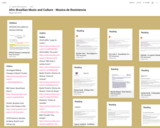
Padlet-based course website for Afro-Brazilian Music and Culture
- Subject:
- Arts and Humanities
- Material Type:
- Full Course
- Provider:
- CUNY
- Provider Set:
- City College
- Author:
- Regina Castro McGowan
- Date Added:
- 03/03/2021

Padlet-based course website for Afro-Brazilian Music and Culture
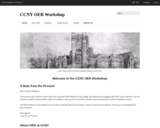
This is the website for the OER Workshop given at CCNY. The workshop is asynchronous, and includes 9 modules for learning about OER.
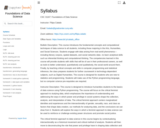
This course introduces the fundamental concepts and computational techniques of data science to all students, including those majoring in the Arts, Humanities, and Social Sciences. Students engage with data arising from real-world phenomena—including literary corpora, spatial datasets, and social networks data—to learn analytical skills such as inferential thinking and computational thinking. The competencies learned in this course will provide students with skills that will be of use in their professional careers, as well as tools to better understand, quantitatively and qualitatively, the social world around them. Finally, by teaching critical concepts and skills in computer programming and statistical inference, the class prepares students for further coursework in technology-dependent subjects, such as Digital Humanities. The course is designed for students who are new to statistics and programming. Students will make use of the Python programming language, but no computer science pre-requisites are required.
Instructor Description: This course is designed to introduce humanities students to the basics of data science using Python programming. The course will focus on the critical feminist approach to studying data, which emphasizes the importance of understanding and addressing the ways in which power and privilege in social systems shape the collection, analysis, and interpretation of data. The critical feminist approach centers marginalized identities and experiences and the intersectionality of gender, sexuality, race, and class as factors that shape data creation, our methods for analyzing data, and the conclusions we can draw from it. Students will explore the ways in which a feminist approach to data science can be used to reinforce or challenge existing power structures and promote social justice.

Brief animation showing how a primary and secondary antibody are used to detect C-fos, an immediate early gene transcribed as a result of recent neural activity. To see why and how C-fos is made please watch the companion video Cfos neural activity

This animation shows how electrical impulses generated by neurons (action potentials) lead to the expression of C-fos by the cell nucleus. C-fos is thus considered an immediate early gene product of recent neural activity. It is widely used in neuroscience as a post-hoc readout of recently active neurons. To see how C-fos is detected experimentally for visualization and quantification please watch the companion video C-fos Immunolabeling.

Cocaine afflicts many individuals and is potently addictive. Originally hailed as a wonder-drug in the late 19th century, cocaine is now considered an illegal substance. Cocaine’s addictive properties can be attributed to changes in the dopamine reward pathway of the Ventral Tegmental Area and Substantia Nigra, Prefrontal Cortex, Dorsal Striatum, Nucleus Accumbens, Amygdala, Globus Pallidus, and Hippocampus. This drug affects the brain in two processes: binge and crave. The binge process highlights cocaine’s ability to block dopamine reuptake from the synapse resulting in hyperstimulation of the postsynaptic neuron in the dopamine reward pathway. The crave process promotes drug-seeking behavior through conditional and contextual cues. Understanding the effects of cocaine in the brain may grant insight in creating future medication and therapies to treat individuals addicted to this drug.

Precise modification of faulty genes for repair has been one of the most important goals in medicine. It is now finally within the realm of possibility thanks to the gene editing tool CRISPR. This microbial adaptive immune system can copy and cut specific DNA sequences. This animation provides a visual introduction of this revolutionary genetic tool.

This syllabus is from the second (and final) level of Ear Training at CCNY. This course is based primarily on popular music.

This animation describes Endochondral Ossification which is a process of long, short and irregular bone formation using byline template.

This animation describes the formation of endocrine glands starting with the mitosis of mesenchymal tissues, eventually leading to the formation of the secretory portion of the gland by differentiation.
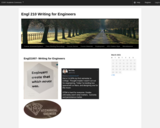
Course website for English 21007: Writing for Engineers at City College of New York.

This animation describes the formation of exocrine glands starting with the mitosis of mesenchymal tissues, eventually leading to the formation of the secretory portion of the gland by differentiation.

This animation describes the process of cartilage formation starting with separation from the mesenchymal tissue to the formation of an isogenous cell group via mitosis.
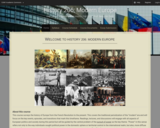
This course surveys the history of Europe from the French Revolution to the present. This covers the traditional periodization of the “modern” era and will focus on the key events, episodes, and transitions that mark this timeframe. Readings, lectures, and discussions will engage with all aspects of European politics and society during this period but will be guided by the central problem of the pursuit of power as the key theme. “Power” in this sense refers not only to the way individuals sought political power in the domestic sphere or territorial control in the international realm, but also, more diffuse notions of power as they appear in daily life, culture, gender relations, race, and social conflict. This focus on power is largely a result of a particular understanding of “modernity” as ultimately an idea that pushed Europeans to develop new ideas about how to best control and order society and the globe. To be modern, in short, meant harnessing the technologies, populations, and institutions of the nation-state to create a more ordered, productive society.
Beginning with the French Revolution, Europeans in the modern era have sought to combine the pursuit of power with the mobilization and participation of mass society, in varying forms. The unleashing of popular sovereignty and the response of the various “isms” of the 19th century (e.g. liberalism, socialism, nationalism) reveal to us the extent to which politics became a question of who should have the power, and how that power ought to be used for the benefit of European societies. Europeans did not only struggle for power in this domestic sense, but also sought to use power abroad and expand the grip of European empire. The modern period, particularly during the “Age of Catastrophe” of the early 20th century, was one marked by warfare that reshaped how violence was conceived. Ultimately, the quest for power led to totalitarian states, the most infamous being Nazi Germany, which sought to control their societies in ways previous unheard of and use extreme forms of violence in doing so. The great cataclysm that was the two world wars destroyed the belief that the use of brute force was the most preferred means of exerting power at home and abroad, and the changes this brought about are evident in the way Europeans conceive and utilize power in today’s world.
Harmonizing with current approaches, this course also seeks to provide a “multi-perspective” overview of Modern Europe, working at different levels of society and engaging with perspectives from larger and smaller European nations. Ultimately, it strives to develop students’ understanding of Europe at large and the changes experienced there over the course of roughly two centuries.

ACRL Framework for Information Literacy for Higher Education, LILIAC/CUNY Information Literacy Standards for CUNY Students

This animation describes Intramembranous ossification which is a process of bone formation.

As one of the oldest artistic forms, theatre has been an enduring witness to the vicissitudes of art and society. This course will offer a survey of the creative dimensions of theatre, such as dramatic literature, directing, acting, scenography, lighting, costume etc. It will also introduce you to the various occupations of this collaborative art, such as director, playwright, dramaturg, designer, producer etc. Meanwhile, we will inquire about the relation between theatre and space, history, politics and society and contemplate our roles as audience and critics in the theatrical experience. The goal for this course is to offer students the means to discuss theatrical experiences (either as theatre makers or spectators) as well as a great variety of theatrical traditions and provide a basis for their future endeavors with this art form. This will require students to have a sound grasp of the course readings, reflect on them critically, articulate their own ideas, and eventually formulate their own understanding of this art form.
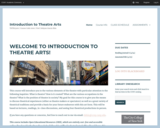
This course will introduce you to the various elements of the theatre with particular attention to the following inquiries: What is theatre? How is it created? What are the various occupations in the theatre? What is the position of theatre in society? My goal for this course is to give you the means to discuss theatrical experiences (either as theatre makers or spectators) as well as a great variety of theatrical traditions and provide a basis for your future endeavors with this art form. This will be based on lectures, readings, in-class discussions, and seeing four theatrical productions in person.
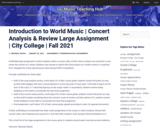
Scaffolded large assignment in which students watch a concert video of their choice, analyze one song from it, and review the concert as a whole. Students may choose to submit their final product as a written review or in podcast form. Designed for online asynchronous class during COVID-19 pandemic.
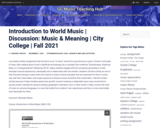
Low-stakes written assignment that functions as an “in-class” activity for asynchronous course. Comes in 3rd week of class, after reading about music’s significance/meanings (as a concept) from textbook “Soundscapes: Exploring Music in a Changing World” (Shelemay 2015). Helps students engage with the concept by grounding it in their everyday musical experiences, individually and in relationship with one another. Students cite this activity as one of their favorites because it gives them the chance to share musical examples that are important for them in some way with their classmates, and to gain exposure to diverse musics shared by their classmates. I like this simple activity because it helps students grasp how specific musical meaning is, dependent upon many social factors (social context, identity/ies, physical setting, geographic orientation, etc); in other words, it helps counter the myth of music as universal language, in a way that builds from students’ own experiences and thus is more memorable and meaningful for them.